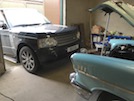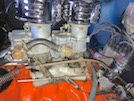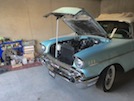:: Diary - February 2017 ::
:: Saturday, February 18, 2017 ::
I have spent the last 4 weeks resisting buying every shiny Chevy bit I can find. Yes, I haven’t bought a single thing.
I’ve been along to the car a couple of times, just to footer about with stuff and try to get it to start. It’s sitting on a trickle charger but even
with that, and a booster pack, it just won’t start. I’m starting to worry that I might have put something together wrong when I had some bits off while
I was painting and cleaning engine bits. I’m pretty sure it’s all right, but this is me, and it wouldn’t be the first time…
Today I remember that I meant to dry out the carpets, after I found them soaking under the driver’s feet. So I take along my mahoosive dehumidifier
and some absorbent cloths. I find that it has pretty much dried out (it’s in a garage with the car windows all open) but I fire up the dehumidifier, and
close all the windows, leaving about a 1/2 inch gap.
Then I have another go at starting it. It turns over, but still no go… bugger…
So I plug in the trickle charger, and piss off home.
:: Sunday, February 19, 2017 ::
Right ya bastard. This thing is starting today, no doubt about it. I load up the Range Rover with a re-charged booster pack, jump leads, and a box of
various tools. I also take the TVR keys in case I have to jump start it from that, if the jump leads don’t reach from the RR outside the garage. I
should explain that I hadn’t noticed with the TVR or the Porsche, but the garage floor has the very slightest of slopes in it, in the last couple of
feet towards the door - so you can push the car out to the door, but the Chevy is too heavy (and the heavies can try) to push back up that slope - so
if it doesn’t start, I’m stuffed).
I disconnect the trickle charger, attach up the booster pack, and it almost bursts into life - it tries, but not quite. Then it turns over, but slower
each time. Nope…
It’s jump start time! After all that farting about worrying about the length of the jump leads and how far forward to push the Chevy, I go for the direct
approach. I drive the Range Rover up to the door and then remember that I forgot to put down the ramps. Fuck it. It goes straight in.
 It only just goes in, mind - it’s not much smaller than the Chevy. Note to self - don’t stall when you have the Chevy half-way through the door - if it
doesn’t start again, you might have a long wait before somebody rescues you and lets you out. I’ve got about 2 inches between the passenger wing and the
door frame, and not much more on the driver side. First problem - how do I squeeze my corpulent frame through that space to get in the garage? Well, you
might be surprised (as I was) to find that I actually fitted through that space, after opening the bonnet release and leaving the engine running so that
I don’t have to go back too often.
It only just goes in, mind - it’s not much smaller than the Chevy. Note to self - don’t stall when you have the Chevy half-way through the door - if it
doesn’t start again, you might have a long wait before somebody rescues you and lets you out. I’ve got about 2 inches between the passenger wing and the
door frame, and not much more on the driver side. First problem - how do I squeeze my corpulent frame through that space to get in the garage? Well, you
might be surprised (as I was) to find that I actually fitted through that space, after opening the bonnet release and leaving the engine running so that
I don’t have to go back too often.
Connect up the leads, jump in the Chevy, and although it sounds as if it’s cranking at much the same speed, it jumps into life instantly. I sit there
relieved that it’s working, but reaching an instant diagnosis of the fundamental underlying problem.
The battery’s fucked.
I think I’ve said before that the battery is really small, much smaller than the tray. The cranking amps were pretty high (575) when it was new, but
that was in February 2012 according to the sticker on it. I measure the battery tray and check online and find that the OE battery was indeed much
bigger (both in physical dimensions and capacity) so I think it was probably struggling when new (although maybe not so much in California where the
temperature might be a bit better) but that confirms my earlier scientific diagnosis that it doesn’t cut the mustard in freezing damp Scotland.
I let the car warm up a bit while I empty out the dehumidifier, which has extracted about a litre of water out of there since yesterday, and although
the carpet now feels bone dry, I’m going to give it another couple of days.
Right, that’s enough for now.
Halfords is on my way home (no, it really is, not on the other side of the city from where you’re going but you decide to drop by anyway, while your
ex-friends wait impatiently). The Halfords assistant asks if he can help, but quickly realises that their system doesn’t cover anything back to 1957.
So they leave me to play with my tape measure among their battery stock.
A type 075 seems to be the closest (slightly smaller, but it will fit - you can’t go bigger because it won’t fit in the tray). They have 3 different
batteries in stock that size. Their own brand doesn’t have anywhere near enough cranking ooomph, so that leaves two, one with 600 amps and one with
620. The first one is £102, and the second one is £155. They are both a Japanese brand which somehow doesn’t seem right for that particular car…
A look online turns up an 075 battery rated at 600 amps CCA and 62Amp-hours, for £44.50. Now I’m a believer in “you only get what you pay for”, but I
also believe in “always fit the biggest fuck-off battery that fits because old sheds need all the help they can get” and “more often, you pay too much
for what you get” in buying car parts, so I decide it’s worth a punt. What’s the worst that could happen? Ok, yes, I know, it could be shite and explode
in a mess of sparks and acid, setting fire to half the car and dissolving the rest, while also burning your eyes out so that at least you’re spared
the misery of watching your car, and maybe your hands and most of your forearms, disappear in front of your bleeding sockets. But apart from that, what’s
the worst that could happen?
:: Tuesday, February 21, 2017 ::
The new battery is delivered today - nice and early too (round about lunch time) so that leaves bags of time to fit it!
So I start with the usual “load the car up with everything I might conceivably need, and quite a few things I won’t” routine, and head along to the farm.
More in hope than realistic expectation, I try the starter. It almost goes, but not quite… ok how long does it take to change a battery? Disconnect
negative, disconnect positive, remove hold-in clamp, battery out. New battery in, clamp down, connect positive, connect negative - about 10 minutes.
And it starts first time!
The only problem is that it’s idling at around 2,000 revs… it was fine yesterday, how can changing the battery affect the idle speed on a car with no
computers etc? (That’s a genuine question, it had me stumped for 5 minutes.)
The answer, of course, is that it can’t. I try pushing the throttles closed manually (twin-carb, remember). No difference. I try blipping the throttle
from under the bonnet. I see one of the “accelerator boost pumps” in the back carb move, but the front one doesn’t. I take off the air filters, and look
down the barrels and open the throttle. The rear throttle opens, the front one doesn’t. Now this is odd because the pedal works the front carb, which is
then linked to the rear one, and the linkage is all moving ok.
All is explained when the linkage falls off the front carb’s throttle spindle. It’s turning, but not fixed to the spindle…
The linkage is fixed to the spindle with two teeny-weeny grub screws, which have come loose. I have to dismantle the linkage rods etc to get the link
back onto the spindle. Then I find I can’t tighten it because I don’t have an Allen key the right size - they are American-sized not metric. Fortunately,
John is in the workshop and digs out two tobacco tins of assorted Allen keys - some metric, some american. After trying several, I find the right one, and
get the link in the right space on the spindle, and tighten it up. Between lack of light, poor eyesight and fingers that are half-dead with cold, this is
not a quick process…
Then I reconnect the pedal linkage and the link between the carbs, and set them up so that both throttles are fully closed, tighten everything up, refit
the throttle return spring, and start it up again. Throttle works, both carbs open and close together. I’m not convinced that the throttles are opening
over their full range though - the accelerator pedal linkage is as far “closed” as it goes, but I don’t think the throttles are fully open before the
pedal hits the carpet. It’s exactly how it was when I started, but that doesn’t necessarily mean it was right! Might need a little bit of adjustment (i.e.
bending of the linkage to the pedal) - we’ll see.
This ten-minute job has now taken me just short of 3 bleeding hours. To be fair, some of that was blethering to John though.
I was planning to fix a tiny water leak from the end of the heater return hose, but the car has warmed up too much and I would rather do it when it’s
cold. Besides, I’m fed up now…
I empty another litre of water out of the dehumidifier - it’s as dry as Death Valley in there now. I move the dehumidifier to the TVR because that feels
a wee bit damp inside too.
:: Wednesday, February 22, 2017 ::
Another bin day. Another night of howling winds. One of my bins (a little bucket-sized thing for waste food) has disappeared altogether, I can’t even see
it further up the street. Magic.
Anyway, while I was lying awake listening to metal cans, plastic bottles and whole wheelie bins blowing past the house, I got to thinking, and I’m still
pretty convinced that the throttles aren’t opening far enough.
So today, the first stop is Screwfix, where I buy a set of every (reasonably) conceivable size of metric and imperial hex keys for nine quid, and then
head back along to the garage.
I take the air filter back off and move the throttle as far as it goes while I look down the barrel - yep, it’s only opening just over half-way, nowhere
near full throttle.
Instead of faffing about with adjustments, let’s start from the basics. I disconnect the throttle linkage to the pedal, and then the linkage between the
two carbs. Look down the rear car, turn its throttle link - it opens all the way. Then the front carb - turn the linkage, it opens just over half, as
before… why no full throttle? I find that the linkage is fouling on the adaptor plate between the carbs and the manifold - the linkage is fixed too far
along the spindle… Who’s a stupid prat then?
The other thing I notice is that the two throttle linkages aren’t exactly parallel - that means that as they open, the linkage will turn the back carb at
a different rate from the front one, and you don’t want that…
So then, using my newly acquired imperial allen key, I loosen the front link on the spindle, and move it out to the end of the spindle, and turn it so that
it’s parallel with the rear one, and tighten it up. Then replace the linkage between the two carbs, making sure they are both still closed when I tighten
it up.
Next step is to connect the pedal linkage, making sure that the pedal is “off” and that I’ve left enough slack in the system so that the throttle return
spring can pull it closed without the pedal linkage holding it open. Once that’s connected up, I replace the throttle return spring and check for full
movement of the pedal - it rubs against the side of the coil when it reaches full throttle - only just, but it does. I disconnect the pedal link again,
and put a slight sideways bend in it to clear the coil. I also turn the coil so that the -ve low tension contact is further from the pedal link - last
thing I want is the coil shorting to earth and cutting engine sparks just when reach full throttle!
 So it looks all set - linkages parallel, throttles closed, pedal linkage unobstructed, kick down cable reconnected. But does it work?
So it looks all set - linkages parallel, throttles closed, pedal linkage unobstructed, kick down cable reconnected. But does it work?
Start it up, new battery starts it first time, it runs like a sweetie, blip the throttle and it returns to idle. Now I’m happier!
So happy, in fact, that I’m also going to fix the leaking water hose. It’s the hose from the heater back to the inlet manifold, and it’s leaking very
slightly at the manifold connection where it has just started to split just behind the clip.. Now, I should really drain the system, replace the hose
and refill it again, but where there’s a lazy shortcut, I’m at the front of the queue (not always successfully - well to be honest, very rarely
successfully, but I never claimed to be a quick learner).
So I put a clamp on the hose to minimise water loss, and get my stuff ready - a screwdriver for the clip, a knife to cut an inch or so off the hose, and
a wee block of wood to as a cutting board. Then I put a basin underneath, where I think any spillage will land. Then I loosen the clip, push it up the
hose - then I pull the hose off, cut the end off and push it back on again, with not a lot of water lost. I tighten up the clip and even remember to take
the hose clamp back off.
The basin has caught about a thimbleful of coolant, but fortunately the floor was there to catch the rest. It’s only about a cupful though, to be fair.
So I start it up again, with the radiator cap off to help the water to circulate and let any air escape, and let it warm up a bit before replacing the cap.
 Here’s my salubrious garage with various clutter - erm I mean spares - and also my patented rubber-ended bonnet prop (aka metal broom handle that was
already almost the right colour!)
Here’s my salubrious garage with various clutter - erm I mean spares - and also my patented rubber-ended bonnet prop (aka metal broom handle that was
already almost the right colour!)
 It only just goes in, mind - it’s not much smaller than the Chevy. Note to self - don’t stall when you have the Chevy half-way through the door - if it
doesn’t start again, you might have a long wait before somebody rescues you and lets you out. I’ve got about 2 inches between the passenger wing and the
door frame, and not much more on the driver side. First problem - how do I squeeze my corpulent frame through that space to get in the garage? Well, you
might be surprised (as I was) to find that I actually fitted through that space, after opening the bonnet release and leaving the engine running so that
I don’t have to go back too often.
It only just goes in, mind - it’s not much smaller than the Chevy. Note to self - don’t stall when you have the Chevy half-way through the door - if it
doesn’t start again, you might have a long wait before somebody rescues you and lets you out. I’ve got about 2 inches between the passenger wing and the
door frame, and not much more on the driver side. First problem - how do I squeeze my corpulent frame through that space to get in the garage? Well, you
might be surprised (as I was) to find that I actually fitted through that space, after opening the bonnet release and leaving the engine running so that
I don’t have to go back too often.

